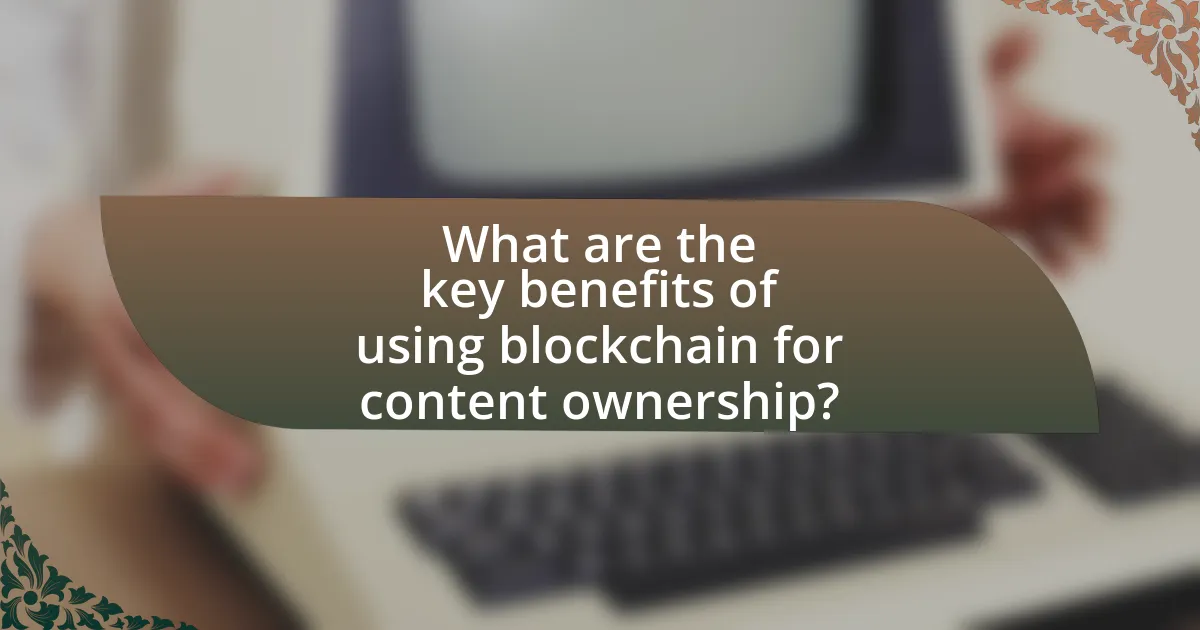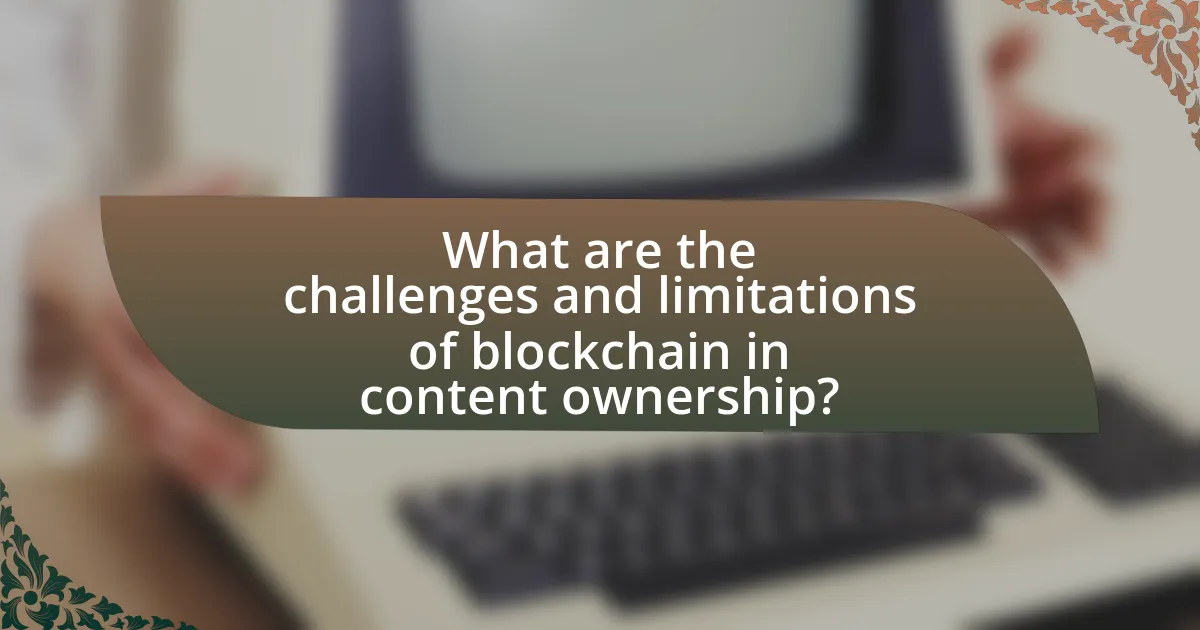Blockchain technology is fundamentally transforming content ownership by enabling decentralized control and transparent tracking of digital assets. This shift empowers creators to maintain ownership rights and receive direct compensation for their work, eliminating the need for intermediaries. Key principles of blockchain, such as decentralization, transparency, and security, enhance the reliability of ownership records and facilitate automated royalty payments through smart contracts. The article explores the implications of these changes, including the financial benefits for creators, the challenges they face in protecting their content, and the future trends in blockchain and content ownership. Additionally, it addresses the legal and regulatory landscape affecting blockchain applications in the content industry.

How is Blockchain Technology Changing Content Ownership?
Blockchain technology is changing content ownership by enabling decentralized control and transparent tracking of digital assets. This shift allows creators to maintain ownership rights and receive direct compensation for their work without intermediaries. For instance, platforms like Audius and OpenSea utilize blockchain to facilitate direct transactions between artists and consumers, ensuring that creators receive a larger share of revenue. Additionally, smart contracts automate royalty payments, providing a reliable and efficient method for content monetization. This transformation is supported by the growing adoption of non-fungible tokens (NFTs), which have generated billions in sales, demonstrating the demand for blockchain-based ownership solutions in the content industry.
What are the fundamental principles of blockchain technology?
The fundamental principles of blockchain technology are decentralization, transparency, immutability, and security. Decentralization ensures that no single entity controls the entire network, allowing for distributed consensus among participants. Transparency allows all transactions to be visible to network participants, fostering trust. Immutability means that once data is recorded on the blockchain, it cannot be altered or deleted, ensuring the integrity of the information. Security is achieved through cryptographic techniques that protect data from unauthorized access and fraud. These principles collectively enable blockchain to transform content ownership by providing a reliable and verifiable method for tracking ownership and transactions.
How does decentralization impact content ownership?
Decentralization significantly enhances content ownership by allowing creators to retain control over their work without reliance on intermediaries. In a decentralized system, such as those enabled by blockchain technology, content is stored on a distributed ledger, ensuring that ownership rights are transparently recorded and immutable. This structure empowers creators to directly monetize their content, as seen in platforms like Audius and OpenSea, where artists can sell their work without traditional gatekeepers. Furthermore, decentralization reduces the risk of censorship and unauthorized use, as ownership is verified through cryptographic methods, providing a secure and trustworthy environment for content creators.
What role do smart contracts play in content ownership?
Smart contracts facilitate content ownership by automating the enforcement of rights and agreements between creators and consumers. They enable creators to define the terms of use, distribution, and payment directly within the contract, ensuring that ownership rights are transparently recorded on the blockchain. This eliminates the need for intermediaries, reduces the risk of copyright infringement, and allows for real-time royalty payments, as transactions are executed automatically when conditions are met. For instance, platforms like Ethereum support smart contracts that can automatically distribute payments to artists whenever their content is accessed, thereby providing a secure and efficient method for managing ownership rights.
Why is content ownership important in the digital age?
Content ownership is crucial in the digital age because it ensures creators retain control over their intellectual property and can monetize their work effectively. In an environment where digital content can be easily copied and distributed, ownership protects against unauthorized use and exploitation. For instance, a study by the World Intellectual Property Organization (WIPO) highlights that creators who maintain ownership of their content can earn up to 50% more in revenue compared to those who relinquish rights. This control not only fosters innovation but also incentivizes creators to produce high-quality content, ultimately benefiting consumers and the economy.
How does traditional content ownership differ from blockchain-based ownership?
Traditional content ownership relies on centralized control, where a single entity, such as a publisher or a production company, holds the rights and can dictate how the content is used, distributed, or monetized. In contrast, blockchain-based ownership decentralizes control, allowing multiple stakeholders to hold and verify ownership through a distributed ledger, which ensures transparency and immutability of ownership records. This shift enables creators to retain more rights and receive direct compensation from consumers, as seen in platforms utilizing smart contracts that automate payments without intermediaries.
What challenges do creators face in protecting their content today?
Creators face significant challenges in protecting their content today, primarily due to rampant piracy, inadequate copyright enforcement, and the complexities of digital rights management. Piracy remains a pervasive issue, with studies indicating that over 80% of digital content is consumed illegally, undermining creators’ revenue. Additionally, traditional copyright laws often struggle to keep pace with the rapid evolution of technology, making it difficult for creators to enforce their rights effectively. Furthermore, digital rights management systems can be cumbersome and may not provide adequate protection against unauthorized use, leading to further exploitation of creators’ work. These challenges highlight the urgent need for innovative solutions, such as blockchain technology, which offers a decentralized and transparent method for securing content ownership and ensuring fair compensation for creators.

What are the key benefits of using blockchain for content ownership?
The key benefits of using blockchain for content ownership include enhanced security, transparency, and control for creators. Blockchain technology provides a decentralized ledger that securely records ownership and transaction history, reducing the risk of unauthorized access or piracy. For instance, a study by the World Economic Forum highlights that blockchain can significantly decrease fraud in digital content by ensuring that all transactions are verifiable and immutable. Additionally, creators can maintain greater control over their work, as smart contracts enable automatic royalty payments and licensing agreements, ensuring they receive fair compensation for their content.
How does blockchain enhance transparency in content ownership?
Blockchain enhances transparency in content ownership by providing a decentralized and immutable ledger that records all transactions related to content. This technology allows creators to register their work on the blockchain, ensuring that ownership and rights are publicly verifiable and cannot be altered without consensus. For instance, once a piece of content is registered, its ownership history is permanently recorded, making it easy to trace back to the original creator. This transparency reduces disputes over ownership and enables fair compensation, as all parties can access the same verified information regarding rights and usage.
What mechanisms ensure traceability of ownership on the blockchain?
Blockchain technology ensures traceability of ownership through mechanisms such as cryptographic hashing, public ledgers, and smart contracts. Cryptographic hashing creates a unique digital fingerprint for each transaction, ensuring that any change in ownership is securely recorded. Public ledgers maintain a transparent and immutable record of all transactions, allowing anyone to verify ownership history. Smart contracts automate the transfer of ownership based on predefined conditions, further enhancing traceability. These mechanisms collectively provide a reliable framework for tracking ownership on the blockchain, as evidenced by the widespread use of blockchain in industries like finance and supply chain management, where accurate ownership records are crucial.
How does transparency affect trust between creators and consumers?
Transparency significantly enhances trust between creators and consumers by providing clear visibility into the processes and practices behind content creation. When creators openly share information about their methods, intentions, and the provenance of their work, consumers feel more secure in their purchasing decisions. For instance, a study by the Edelman Trust Barometer found that 81% of consumers need to trust a brand to buy from them, highlighting the critical role of transparency in fostering that trust. Furthermore, in the context of blockchain technology, the immutable and transparent nature of blockchain records allows consumers to verify the authenticity and ownership of digital content, thereby reinforcing their trust in creators.
What financial benefits can creators gain from blockchain technology?
Creators can gain significant financial benefits from blockchain technology through enhanced revenue streams, reduced transaction costs, and improved ownership rights. Blockchain enables creators to sell their work directly to consumers via smart contracts, which automate payments and ensure creators receive a larger share of the revenue, often up to 90%, compared to traditional platforms that typically take substantial commissions. Additionally, blockchain’s decentralized nature reduces intermediaries, lowering transaction fees and increasing overall profitability. Furthermore, the use of non-fungible tokens (NFTs) allows creators to monetize digital assets uniquely, providing opportunities for royalties on secondary sales, thereby generating ongoing income. These financial advantages are supported by the growing adoption of blockchain in various industries, with the NFT market alone reaching a valuation of over $10 billion in 2021, demonstrating the potential for creators to capitalize on this technology.
How does blockchain facilitate direct payments to content creators?
Blockchain facilitates direct payments to content creators by enabling peer-to-peer transactions without intermediaries. This technology utilizes smart contracts, which automatically execute payment agreements when predefined conditions are met, ensuring that creators receive funds instantly upon content consumption or sale. For instance, platforms like Audius and OpenSea leverage blockchain to allow artists to receive payments directly in cryptocurrency, eliminating the need for traditional payment processors that often charge high fees. This direct payment model not only increases the revenue share for creators but also enhances transparency, as all transactions are recorded on an immutable ledger, allowing creators to track their earnings in real-time.
What are the implications of reduced intermediaries in content distribution?
Reduced intermediaries in content distribution lead to increased efficiency, lower costs, and enhanced control for content creators. By eliminating middlemen, creators can directly reach their audience, resulting in higher profit margins and reduced transaction fees. For instance, blockchain technology facilitates peer-to-peer transactions, allowing artists to sell their work directly to consumers without the need for traditional distribution channels. This shift not only empowers creators but also fosters a more transparent ecosystem, as blockchain provides immutable records of ownership and transactions, ensuring that creators receive fair compensation for their work.

What are the challenges and limitations of blockchain in content ownership?
The challenges and limitations of blockchain in content ownership include scalability issues, regulatory uncertainty, and the complexity of user interfaces. Scalability is a significant concern, as many blockchain networks struggle to handle a high volume of transactions efficiently; for instance, Ethereum can process only about 30 transactions per second, which can lead to delays and increased costs during peak usage. Regulatory uncertainty arises because the legal status of blockchain-based content ownership is still evolving, creating risks for creators and consumers alike. Additionally, the complexity of user interfaces can hinder widespread adoption, as many users find blockchain technology difficult to navigate, which limits its accessibility and usability.
What technical barriers exist for widespread adoption of blockchain technology?
The technical barriers for widespread adoption of blockchain technology include scalability issues, interoperability challenges, and energy consumption concerns. Scalability issues arise because many blockchain networks struggle to process a high volume of transactions quickly; for instance, Bitcoin can handle approximately 7 transactions per second, while Visa can handle over 24,000. Interoperability challenges exist as different blockchain platforms often cannot communicate with each other, limiting the ability to transfer assets across networks. Additionally, energy consumption concerns are significant, as the proof-of-work consensus mechanism used by many blockchains, such as Bitcoin, requires substantial computational power, leading to environmental sustainability debates. These barriers hinder the seamless integration of blockchain technology into various sectors, including content ownership.
How does scalability affect blockchain’s ability to handle large volumes of content?
Scalability directly impacts blockchain’s ability to handle large volumes of content by determining the network’s capacity to process transactions efficiently. A scalable blockchain can accommodate increased transaction loads without significant delays or increased costs, which is crucial for applications involving high volumes of content, such as digital media and asset management. For instance, Ethereum’s transition to a proof-of-stake model aims to enhance scalability, allowing it to process thousands of transactions per second compared to its previous capacity of around 15 transactions per second. This improvement is essential for supporting platforms that require rapid content updates and transactions, thereby ensuring seamless user experiences and effective content ownership management.
What are the security concerns associated with blockchain technology?
Security concerns associated with blockchain technology include vulnerabilities to hacking, data privacy issues, and the potential for smart contract exploits. Hacking incidents, such as the 2016 DAO attack, resulted in the loss of $60 million worth of Ether, highlighting the risks of decentralized applications. Data privacy is a concern because blockchain’s transparency can expose sensitive information, as seen in public blockchains where transaction details are accessible to anyone. Additionally, smart contracts, which automate transactions, can contain coding errors or vulnerabilities that malicious actors can exploit, leading to financial losses. These concerns necessitate robust security measures and ongoing scrutiny to protect users and their assets.
How do legal and regulatory issues impact blockchain content ownership?
Legal and regulatory issues significantly impact blockchain content ownership by determining the enforceability of ownership rights and the protection of intellectual property. For instance, varying jurisdictions have different laws regarding copyright, which can complicate the recognition of ownership for digital assets recorded on a blockchain. Additionally, regulations concerning data privacy, such as the General Data Protection Regulation (GDPR) in Europe, can affect how content is stored and accessed on blockchain platforms, potentially limiting the ability to transfer ownership or modify content. These legal frameworks create a landscape where content creators must navigate complex legalities to ensure their rights are upheld, influencing how blockchain technology is utilized for content ownership.
What current laws affect the use of blockchain for content ownership?
Current laws affecting the use of blockchain for content ownership include intellectual property laws, data protection regulations, and contract laws. Intellectual property laws, such as copyright and trademark laws, govern the ownership and protection of creative works, which can be recorded on blockchain to establish provenance and ownership. Data protection regulations, like the General Data Protection Regulation (GDPR) in Europe, impact how personal data is handled on blockchain platforms, particularly concerning user consent and data rights. Additionally, contract laws influence the enforceability of smart contracts on blockchain, determining how agreements related to content ownership are executed and upheld. These legal frameworks collectively shape the landscape for blockchain applications in content ownership.
How can creators navigate copyright issues in a blockchain environment?
Creators can navigate copyright issues in a blockchain environment by utilizing smart contracts to define ownership and usage rights clearly. Smart contracts automate the enforcement of copyright terms, ensuring that creators receive royalties and control over their work. For instance, platforms like Audius and OpenSea leverage blockchain technology to provide transparent tracking of ownership and transactions, which helps in resolving disputes. Additionally, creators should register their works on blockchain-based platforms that offer timestamping and proof of ownership, which can serve as legal evidence in case of infringement. This approach aligns with the growing trend of decentralized content distribution, where creators maintain more control over their intellectual property.

What future trends can we expect in blockchain and content ownership?
Future trends in blockchain and content ownership include increased decentralization, enhanced transparency, and the rise of non-fungible tokens (NFTs) for digital assets. Decentralization allows creators to retain ownership and control over their content without intermediaries, as evidenced by platforms like Audius, which empowers musicians to distribute their work directly. Enhanced transparency will enable users to track the provenance of digital content, reducing piracy and ensuring fair compensation, supported by blockchain’s immutable ledger. The proliferation of NFTs is transforming how digital art and collectibles are bought and sold, with the NFT market reaching over $10 billion in sales in 2021, indicating a significant shift in ownership models. These trends suggest a future where content ownership is more equitable and accessible.
How might blockchain technology evolve in the content industry?
Blockchain technology is likely to evolve in the content industry by enhancing transparency, security, and ownership rights for creators. As decentralized platforms gain traction, they will enable direct transactions between creators and consumers, reducing reliance on intermediaries. This shift can lead to more equitable revenue distribution, as evidenced by projects like Audius, which allows musicians to publish and monetize their work directly on the blockchain. Additionally, smart contracts will automate licensing agreements, ensuring that creators receive fair compensation in real-time. The integration of non-fungible tokens (NFTs) will further revolutionize ownership by allowing unique digital assets to be bought, sold, and traded, providing verifiable proof of ownership. Overall, these advancements will create a more democratized content ecosystem, empowering creators and enhancing user engagement.
What innovations are on the horizon for content creators using blockchain?
Innovations on the horizon for content creators using blockchain include decentralized content distribution platforms, enhanced royalty tracking systems, and the integration of non-fungible tokens (NFTs) for unique digital assets. Decentralized platforms enable creators to publish and monetize their work directly, reducing reliance on intermediaries and increasing revenue share. Enhanced royalty tracking systems utilize smart contracts to ensure creators receive fair compensation in real-time, addressing issues of transparency and trust. The integration of NFTs allows creators to tokenize their work, providing proof of ownership and enabling new revenue streams through secondary sales. These advancements are supported by the growing adoption of blockchain technology across various industries, indicating a shift towards more equitable content ownership models.
How could emerging technologies integrate with blockchain for content ownership?
Emerging technologies such as artificial intelligence, the Internet of Things (IoT), and augmented reality can integrate with blockchain to enhance content ownership by providing secure, verifiable, and efficient management of digital assets. For instance, AI can automate the process of verifying ownership and authenticity of content through smart contracts on the blockchain, ensuring that creators receive fair compensation for their work. IoT devices can track the usage and distribution of content in real-time, enabling transparent royalty distribution based on actual consumption. Augmented reality can create immersive experiences tied to blockchain-verified content, allowing users to interact with digital assets while ensuring that ownership rights are maintained. This integration not only streamlines the content ownership process but also fosters trust among creators and consumers, as blockchain’s immutable ledger provides a reliable record of ownership and transactions.
What practical steps can creators take to leverage blockchain technology?
Creators can leverage blockchain technology by minting non-fungible tokens (NFTs) for their digital content, which establishes verifiable ownership and provenance. By creating NFTs, creators can ensure that their work is uniquely identified on the blockchain, allowing for secure transactions and royalties on secondary sales. Additionally, creators can utilize decentralized platforms for distribution, which reduces reliance on traditional intermediaries and increases profit margins. The use of smart contracts can automate royalty payments, ensuring creators receive compensation directly and transparently. These steps are supported by the growing adoption of blockchain in the creative industries, with reports indicating that NFT sales reached $10.7 billion in Q3 2021, highlighting the financial viability of this approach.
How can creators start using blockchain for their content today?
Creators can start using blockchain for their content today by utilizing platforms that support decentralized content distribution and ownership. These platforms, such as Ethereum-based applications, allow creators to mint non-fungible tokens (NFTs) representing their work, enabling them to sell, license, or trade their content directly with consumers. For instance, OpenSea and Rarible are popular marketplaces where creators can list their digital art or music as NFTs, ensuring they retain ownership and receive royalties from future sales. This approach not only enhances transparency in transactions but also provides creators with a new revenue stream, as evidenced by the $2.5 billion in NFT sales recorded in the first quarter of 2021 alone.
What resources are available for learning about blockchain and content ownership?
Comprehensive resources for learning about blockchain and content ownership include online courses, academic papers, and industry reports. Platforms like Coursera and edX offer courses specifically on blockchain technology, while websites such as Medium and CoinDesk provide articles and insights on content ownership issues related to blockchain. Additionally, research papers from institutions like MIT and Stanford, such as “Blockchain Technology: Beyond Bitcoin” by Arvind Narayanan et al., offer in-depth analysis and foundational knowledge. These resources collectively enhance understanding of how blockchain is reshaping content ownership.




